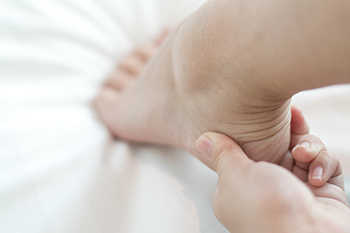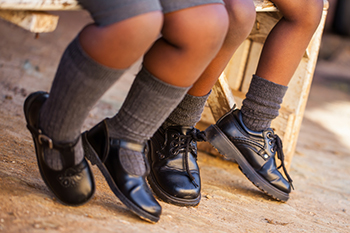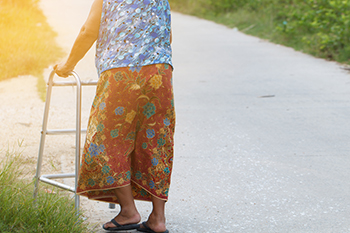Blog
Items filtered by date: February 2023
Signs Your Child May Have Sever’s Disease

Sever's disease is a painful foot condition typically affecting active children and young teenagers. It happens as a result of an inflammation of the growth plate in the heel. This causes the heel bone to grow faster than the surrounding muscles and tendons, and pain can be felt in the back of the heel. It can affect the area where the Achilles tendon attaches to the heel bone, and calf pain may develop. This can gradually occur, and children may begin to limp. They may also walk on tiptoes. The symptoms can become more frequent with increased activity. Certain conditions like high arches, flat feet, and obesity might make children susceptible to Sever’s disease. Relief is generally found when the activity that caused this condition is temporarily stopped. It can also be helpful to elevate the feet. If your child has Sever’s disease, it is suggested that you schedule an appointment with a podiatrist who can determine the correct form of treatment and prescribe custom-made orthotics, if necessary.
Sever's disease often occurs in children and teens. If your child is experiencing foot or ankle pain, see one of our doctors from Kitsap Foot & Ankle Clinic. Our doctors can treat your child’s foot and ankle needs.
Sever’s Disease
Sever’s disease is also known as calcaneal apophysitis, which is a medical condition that causes heel pain I none or both feet. The disease is known to affect children between the ages of 8 and 14.
Sever’s disease occurs when part of the child’s heel known as the growth plate (calcaneal epiphysis) is attached to the Achilles tendon. This area can suffer injury when the muscles and tendons of the growing foot do not keep pace with bone growth. Therefore, the constant pain which one experiences at the back of the heel will make the child unable to put any weight on the heel. The child is then forced to walk on their toes.
Symptoms
Acute pain – Pain associated with Sever’s disease is usually felt in the heel when the child engages in physical activity such as walking, jumping and or running.
Highly active – Children who are very active are among the most susceptible in experiencing Sever’s disease, because of the stress and tension placed on their feet.
If you have any questions, please feel free to contact one of our offices located in Bremerton and Port Orchard, WA . We offer the newest diagnostic and treatment technologies for all your foot and ankle injuries.
What Is Cuboid Syndrome?

Cuboid syndrome causes lateral, or side, midfoot pain. It is thought to be a result of injury to the calcaneocuboid joint because of a recurrent or forceful impact on the cuboid bone. The cuboid is a small midfoot bone that connects the outer metatarsals to the heel bone. A person with cuboid syndrome usually has swelling, lateral foot pain, and an unnatural gait. This can happen from running over a protrusion in the ground, such as a tree root, spraining one’s ankle that does not respond to treatment, or from peroneal tendinopathy, which is overuse of the peroneal tendons. Diagnosis is often made by taking a history of the patient, asking about any injuries incurred, and examining the foot. If you are suffering from lateral midfoot pain, it is a good idea to see a podiatrist for a proper diagnosis and treatment.
Cuboid syndrome, also known as cuboid subluxation, occurs when the joints and ligaments near the cuboid bone in the foot become torn. If you have cuboid syndrome, consult with one of our doctors from Kitsap Foot & Ankle Clinic. Our doctors will assess your condition and provide you with quality foot and ankle treatment.
Cuboid syndrome is a common cause of lateral foot pain, which is pain on the outside of the foot. The condition may happen suddenly due to an ankle sprain, or it may develop slowly overtime from repetitive tension through the bone and surrounding structures.
Causes
The most common causes of cuboid syndrome include:
- Injury – The most common cause of this ailment is an ankle sprain.
- Repetitive Strain – Tension placed through the peroneus longus muscle from repetitive activities such as jumping and running may cause excessive traction on the bone causing it to sublux.
- Altered Foot Biomechanics – Most people suffering from cuboid subluxation have flat feet.
Symptoms
A common symptom of cuboid syndrome is pain along the outside of the foot which can be felt in the ankle and toes. This pain may create walking difficulties and may cause those with the condition to walk with a limp.
Diagnosis
Diagnosis of cuboid syndrome is often difficult, and it is often misdiagnosed. X-rays, MRIs and CT scans often fail to properly show the cuboid subluxation. Although there isn’t a specific test used to diagnose cuboid syndrome, your podiatrist will usually check if pain is felt while pressing firmly on the cuboid bone of your foot.
Treatment
Just as the range of causes varies widely, so do treatments. Some more common treatments are ice therapy, rest, exercise, taping, and orthotics.
If you have any questions, please feel free to contact one of our offices located in Bremerton and Port Orchard, WA . We offer the newest diagnostic and treatment technologies for all your foot care needs.
Heel Pain Can Be Treated!
Children’s Foot Deformities

When a child is growing and maturing, it is essential that the parent protects the health of their child’s feet. Ensuring proper foot health will help the child grow up with strong, functional feet. This is critical to overall wellbeing and health. However, certain deformities in children’s feet can complicate the health of their feet. Specifically, clubfoot, or congenital talipes equinovarus, is the most obvious deformity that can develop in children. This condition is defined by an awkward and unnatural positioning of the feet where the foot is turned in and resembles the head of a golf club. Importantly, there are three different types or tiers, of this condition. If you are someone that is caring for a newborn baby with this ailment, please consider contacting a podiatrist who can offer you medical advice that can help you to care for your child.
Making sure that your children maintain good foot health is very important as they grow. If you have any questions, contact one of our doctors of Kitsap Foot & Ankle Clinic. Our doctors can provide the care you need to keep you pain-free and on your feet.
Keeping Children's Feet Healthy
Having healthy feet during childhood can help prevent medical problems later in life, namely in the back and legs. As children grow, their feet require different types of care. Here are some things to consider...
Although babies do not walk yet, it is still very important to take care of their feet.
Avoid putting tight shoes or socks on his or her feet.
Allow the baby to stretch and kick his or her feet to feel comfortable.
As a toddler, kids are now on the move and begin to develop differently. At this age, toddlers are getting a feel for walking, so don’t be alarmed if your toddler is unsteady or ‘walks funny’.
As your child gets older, it is important to teach them how to take care of their feet.
Show them proper hygiene to prevent infections such as fungus.
Be watchful for any pain or injury.
Have all injuries checked by a doctor as soon as possible.
Comfortable, protective shoes should always be worn, especially at play.
If you have any questions please feel free to contact one of our offices located in Bremerton and Port Orchard, WA . We offer the newest diagnostic and treatment technologies for all your foot and ankle needs.
Falling Can Affect the Feet

Devastating injuries such as hip fractures or broken ankles may increase with the older population. This may happen as a result of falling, and it is essential to implement fall prevention techniques that may help to prevent injuries. Research has indicated that falling is the main cause of fatal and nonfatal injuries for people who are 65 years and older. Simple methods can be put into place that can possibly help to avoid this. Performing a daily exercise routine is effective in building and maintaining strength in the body. This can help to improve flexibility, range of motion, and balance. Additionally, installing grab bars in the shower and toilet areas is beneficial in avoiding falls on slippery surfaces. Many people choose to have brighter lighting in the household and remove worn rugs. If you would like more information about how falling can affect the feet and how to avoid this, please consult with a podiatrist who can provide you with the information you are seeking.
Preventing falls among the elderly is very important. If you are older and have fallen or fear that you are prone to falling, consult with one of our doctors from Kitsap Foot & Ankle Clinic. Our doctors will assess your condition and provide you with quality advice and care.
Every 11 seconds, an elderly American is being treated in an emergency room for a fall related injury. Falls are the leading cause of head and hip injuries for those 65 and older. Due to decreases in strength, balance, senses, and lack of awareness, elderly persons are very susceptible to falling. Thankfully, there are a number of things older persons can do to prevent falls.
How to Prevent Falls
Some effective methods that older persons can do to prevent falls include:
- Enrolling in strength and balance exercise program to increase balance and strength
- Periodically having your sight and hearing checked
- Discuss any medications you have with a doctor to see if it increases the risk of falling
- Clearing the house of falling hazards and installing devices like grab bars and railings
- Utilizing a walker or cane
- Wearing shoes that provide good support and cushioning
- Talking to family members about falling and increasing awareness
Falling can be a traumatic and embarrassing experience for elderly persons; this can make them less willing to leave the house, and less willing to talk to someone about their fears of falling. Doing such things, however, will increase the likelihood of tripping or losing one’s balance. Knowing the causes of falling and how to prevent them is the best way to mitigate the risk of serious injury.
If you have any questions, please feel free to contact one of our offices located in Bremerton and Port Orchard, WA . We offer the newest diagnostic and treatment technologies for all your foot care needs.

